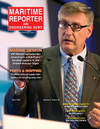
Page 53: of Maritime Reporter Magazine (September 2021)
The Marine Design Edition
Read this page in Pdf, Flash or Html5 edition of September 2021 Maritime Reporter Magazine
SHIPPING & PORTS TECHNOLOGY ted transducers, as shown in Figure 4. port. By effectively removing the de- communal berths for ships have a clear
These are designed to transmit Ultra mand for generated power, the need for potential to act as ‘hot spots’ for the
Sonic Frequencies, creating non-inertial signi? cant quantities of cooling water transfer of biofouling species. A more cavitation which is designed to destroy is also removed and the cooling water detailed understanding of the complex- the biofouling organisms within the pumps may be stopped altogether sub- ity of wet dock biological mechanisms, cooling system in a localized manner ject to vessel design. This would signif- with a particular reference to the in? u- without the use of potentially harmful icantly reduce the risk of IAS transfer ence of ship processes, could assist with compounds. It is worthy to note that the from the cooling water system. This more effective port environmental man- use of this ultrasonic technology is not technology is now available in several agement, reduce the risk of IAS trans- limited to sea water cooling systems and North America and European Ports and mission and assist with the compliance has been employed to counter marine is growing in use. with other regulatory demands such as biofouling in other areas of a ship such It is noted that wet docks offering water quality directives.
as on propellors and rudders
Given the large quantity of cooling
Figure 4
Figure 5. water that is taken up and discharged
Ultrasonic Transducer arrangement ? tted by the cooling pumps ? tted to a ship, to a ship’s sea chest it is often the case that the cooling wa- ter pump capacity may be set at a ? xed rate to accommodate all the calculated heat exchange requirements when the vessel is at sea with her main engines and all other associated machinery running.
When in a wet dock, it may be useful to be able to control the pump speed directly to reduce the throughput of cooling water rather than using a by- pass system to alter the water ? ow to the heat exchanger. Investigative work by Theotokas (2017) showed that the use of variable speed pumps (VSP) for the cooling systems could not only reduce the annual power consumption of a ship but also increase system per- formance by closer control of key tem- perature parameters. Another advan-
H Eustice tage of using VSP in this case would be the reduced volume of water being circulated between ships in a wet dock and hence a lower risk of IAS spread
MAG DRILLS & ANNULAR CUTTERS within the dock.
Possibly the most effective measure
From small lightweight low profile mag drills to large multi-speed models and a wide range of annular to combat the movement of IAS within cutters, Hougen has the power, performance & a wet dock and indeed at any port facili- solutions for your holemaking needs.needs.
ty would be not to use the ships machin- ery to generate electrical power when at a berth but instead use a shore electrical supply. This technology is termed ‘Cold
Ironing’ and was ? rst introduced sev- eral years ago as a measure to reduce
Greenhouse Gas Emissions by ships in 8004267818SERVICE 800-426-7818 SERVICE • INTEGRITY • RELIABILITY HOUGEN.COM www.marinelink.com 53
MR #9 (50-59).indd 53 9/7/2021 4:55:17 PM

 52
52

 54
54
